Evaluation of Leadership and Management Functions at Sainsbury's
VerifiedAdded on 2023/01/05
|13
|3551
|100
Report
AI Summary
This report provides an in-depth analysis of leadership and management practices at Sainsbury's, a major UK supermarket chain. It begins by defining and comparing leadership and management, exploring various leadership theories such as trait theory, behavioral theory, and charismatic leadership, alongside management theories like Frederick Taylor's and McGregor's Theory X and Y. The report then examines Sainsbury's key performance metrics, including the McKinsey 7S model, and discusses the impact of leadership and management on employee performance, incorporating motivational theories like Maslow's hierarchy of needs and Herzberg's two-factor theory. The analysis highlights how leadership styles and managerial functions contribute to organizational development and growth, offering insights into Sainsbury's strategies for employee engagement, quality, market share, and profit, while addressing factors like employee turnover and conflicts. The report also includes a comparison with ASDA to provide a broader context of the competitive landscape.
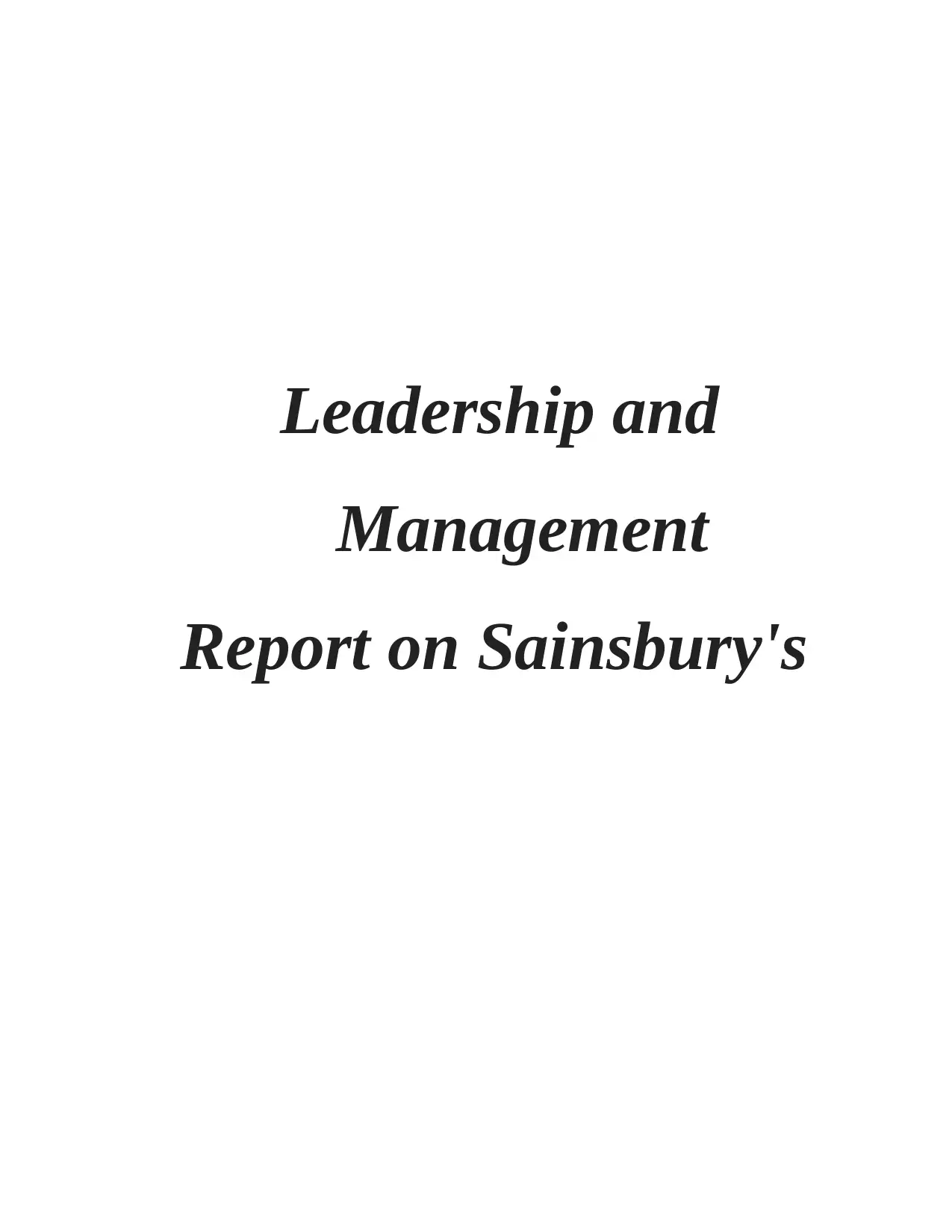
Leadership and
Management
Report on Sainsbury's
Management
Report on Sainsbury's
Paraphrase This Document
Need a fresh take? Get an instant paraphrase of this document with our AI Paraphraser
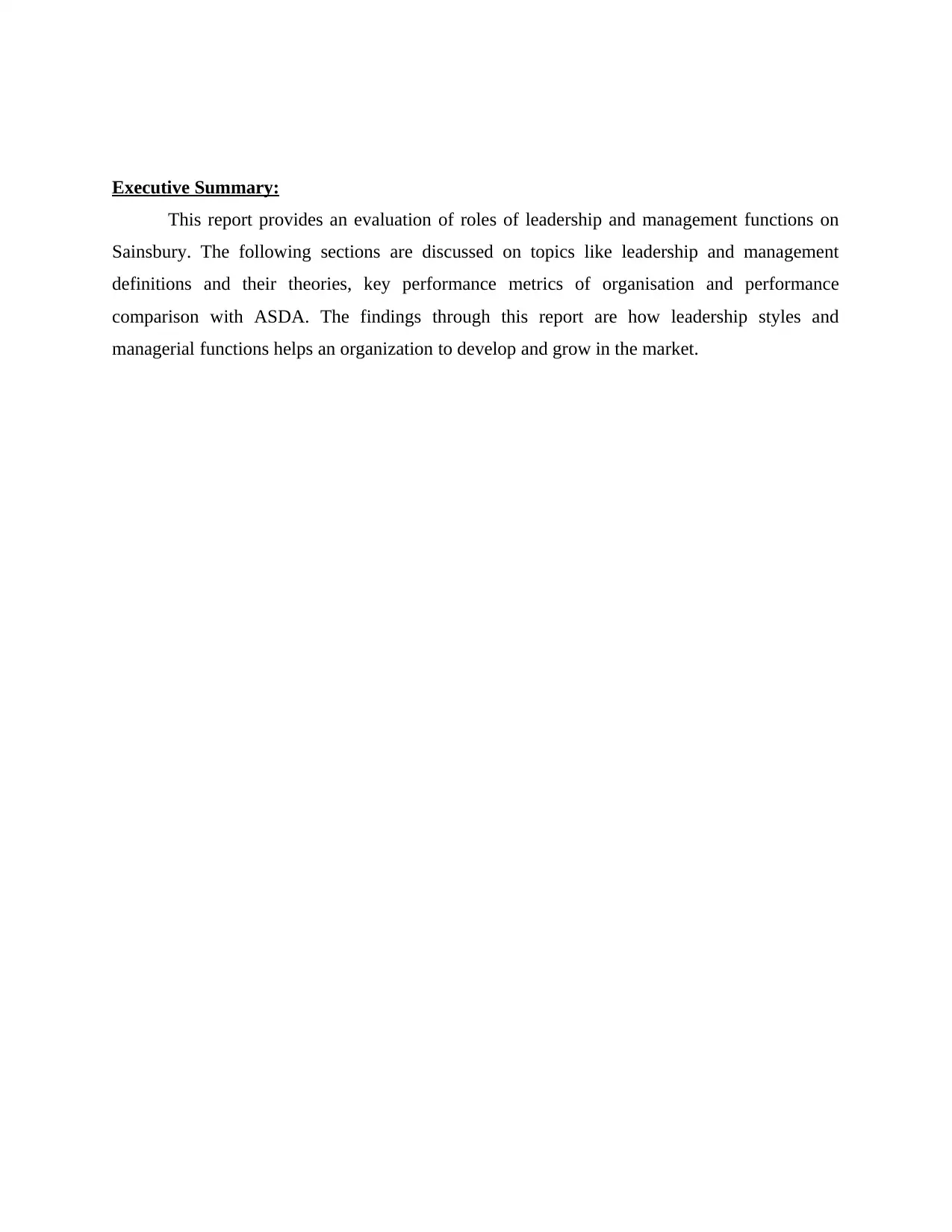
Executive Summary:
This report provides an evaluation of roles of leadership and management functions on
Sainsbury. The following sections are discussed on topics like leadership and management
definitions and their theories, key performance metrics of organisation and performance
comparison with ASDA. The findings through this report are how leadership styles and
managerial functions helps an organization to develop and grow in the market.
This report provides an evaluation of roles of leadership and management functions on
Sainsbury. The following sections are discussed on topics like leadership and management
definitions and their theories, key performance metrics of organisation and performance
comparison with ASDA. The findings through this report are how leadership styles and
managerial functions helps an organization to develop and grow in the market.
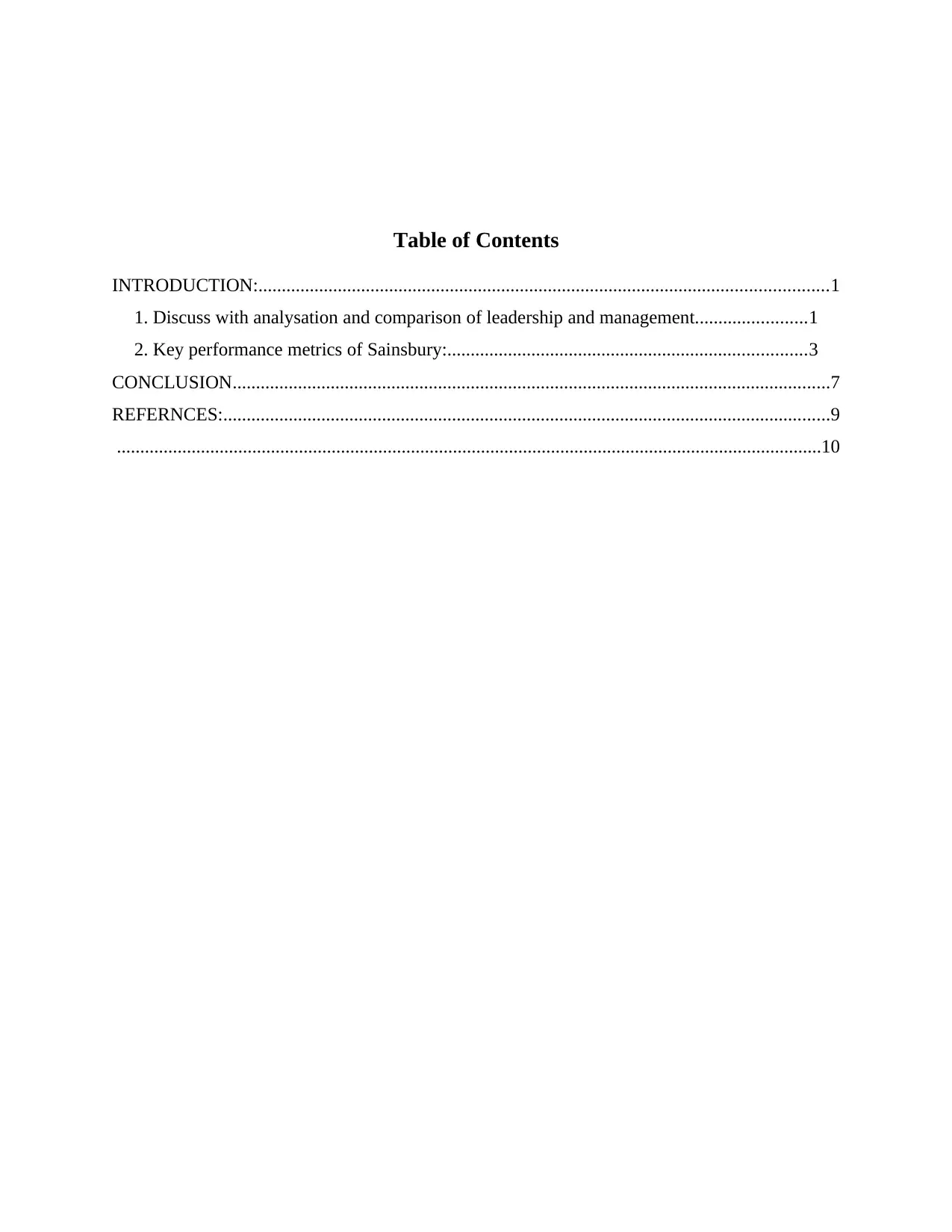
Table of Contents
INTRODUCTION:..........................................................................................................................1
1. Discuss with analysation and comparison of leadership and management........................1
2. Key performance metrics of Sainsbury:.............................................................................3
CONCLUSION................................................................................................................................7
REFERNCES:..................................................................................................................................9
.......................................................................................................................................................10
INTRODUCTION:..........................................................................................................................1
1. Discuss with analysation and comparison of leadership and management........................1
2. Key performance metrics of Sainsbury:.............................................................................3
CONCLUSION................................................................................................................................7
REFERNCES:..................................................................................................................................9
.......................................................................................................................................................10
⊘ This is a preview!⊘
Do you want full access?
Subscribe today to unlock all pages.

Trusted by 1+ million students worldwide
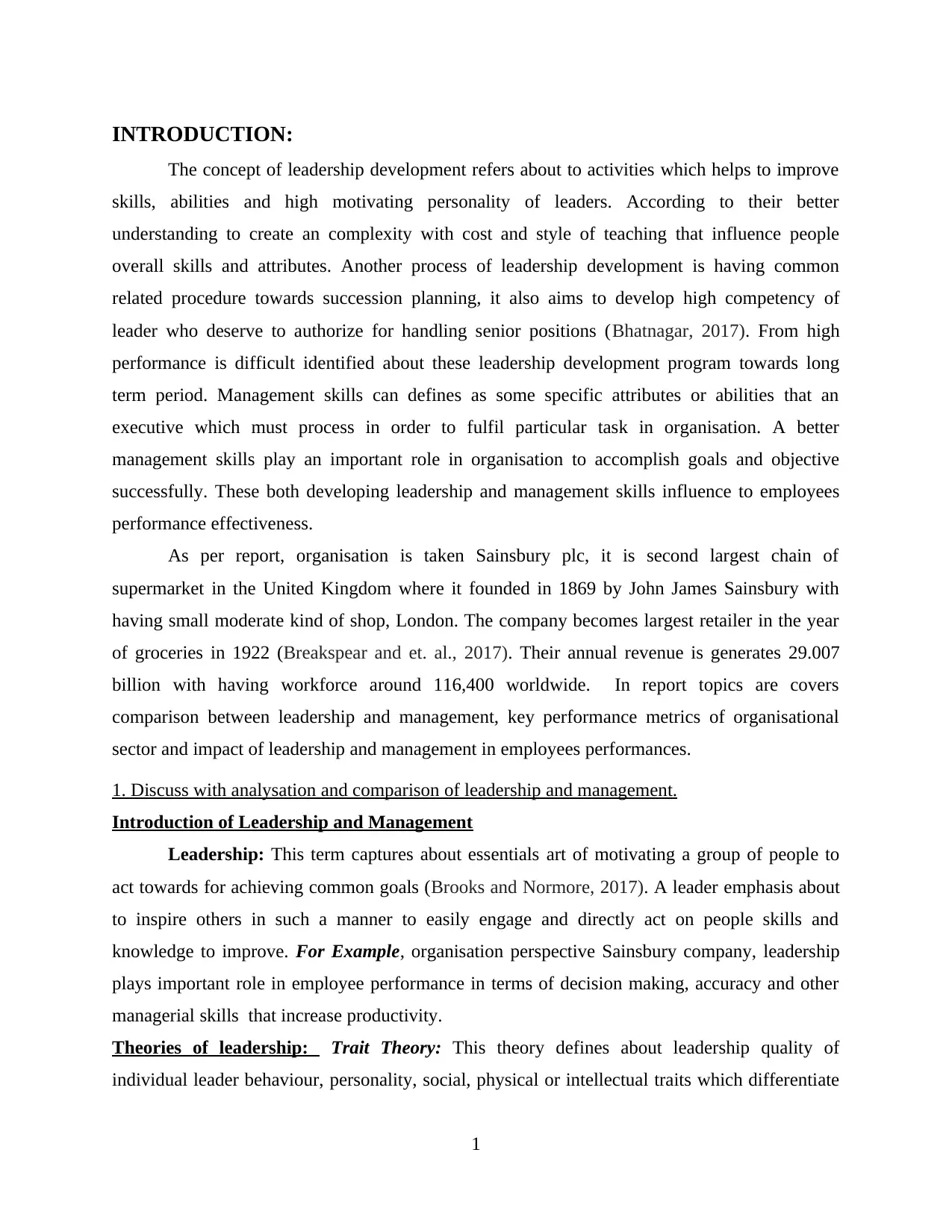
INTRODUCTION:
The concept of leadership development refers about to activities which helps to improve
skills, abilities and high motivating personality of leaders. According to their better
understanding to create an complexity with cost and style of teaching that influence people
overall skills and attributes. Another process of leadership development is having common
related procedure towards succession planning, it also aims to develop high competency of
leader who deserve to authorize for handling senior positions (Bhatnagar, 2017). From high
performance is difficult identified about these leadership development program towards long
term period. Management skills can defines as some specific attributes or abilities that an
executive which must process in order to fulfil particular task in organisation. A better
management skills play an important role in organisation to accomplish goals and objective
successfully. These both developing leadership and management skills influence to employees
performance effectiveness.
As per report, organisation is taken Sainsbury plc, it is second largest chain of
supermarket in the United Kingdom where it founded in 1869 by John James Sainsbury with
having small moderate kind of shop, London. The company becomes largest retailer in the year
of groceries in 1922 (Breakspear and et. al., 2017). Their annual revenue is generates 29.007
billion with having workforce around 116,400 worldwide. In report topics are covers
comparison between leadership and management, key performance metrics of organisational
sector and impact of leadership and management in employees performances.
1. Discuss with analysation and comparison of leadership and management.
Introduction of Leadership and Management
Leadership: This term captures about essentials art of motivating a group of people to
act towards for achieving common goals (Brooks and Normore, 2017). A leader emphasis about
to inspire others in such a manner to easily engage and directly act on people skills and
knowledge to improve. For Example, organisation perspective Sainsbury company, leadership
plays important role in employee performance in terms of decision making, accuracy and other
managerial skills that increase productivity.
Theories of leadership: Trait Theory: This theory defines about leadership quality of
individual leader behaviour, personality, social, physical or intellectual traits which differentiate
1
The concept of leadership development refers about to activities which helps to improve
skills, abilities and high motivating personality of leaders. According to their better
understanding to create an complexity with cost and style of teaching that influence people
overall skills and attributes. Another process of leadership development is having common
related procedure towards succession planning, it also aims to develop high competency of
leader who deserve to authorize for handling senior positions (Bhatnagar, 2017). From high
performance is difficult identified about these leadership development program towards long
term period. Management skills can defines as some specific attributes or abilities that an
executive which must process in order to fulfil particular task in organisation. A better
management skills play an important role in organisation to accomplish goals and objective
successfully. These both developing leadership and management skills influence to employees
performance effectiveness.
As per report, organisation is taken Sainsbury plc, it is second largest chain of
supermarket in the United Kingdom where it founded in 1869 by John James Sainsbury with
having small moderate kind of shop, London. The company becomes largest retailer in the year
of groceries in 1922 (Breakspear and et. al., 2017). Their annual revenue is generates 29.007
billion with having workforce around 116,400 worldwide. In report topics are covers
comparison between leadership and management, key performance metrics of organisational
sector and impact of leadership and management in employees performances.
1. Discuss with analysation and comparison of leadership and management.
Introduction of Leadership and Management
Leadership: This term captures about essentials art of motivating a group of people to
act towards for achieving common goals (Brooks and Normore, 2017). A leader emphasis about
to inspire others in such a manner to easily engage and directly act on people skills and
knowledge to improve. For Example, organisation perspective Sainsbury company, leadership
plays important role in employee performance in terms of decision making, accuracy and other
managerial skills that increase productivity.
Theories of leadership: Trait Theory: This theory defines about leadership quality of
individual leader behaviour, personality, social, physical or intellectual traits which differentiate
1
Paraphrase This Document
Need a fresh take? Get an instant paraphrase of this document with our AI Paraphraser
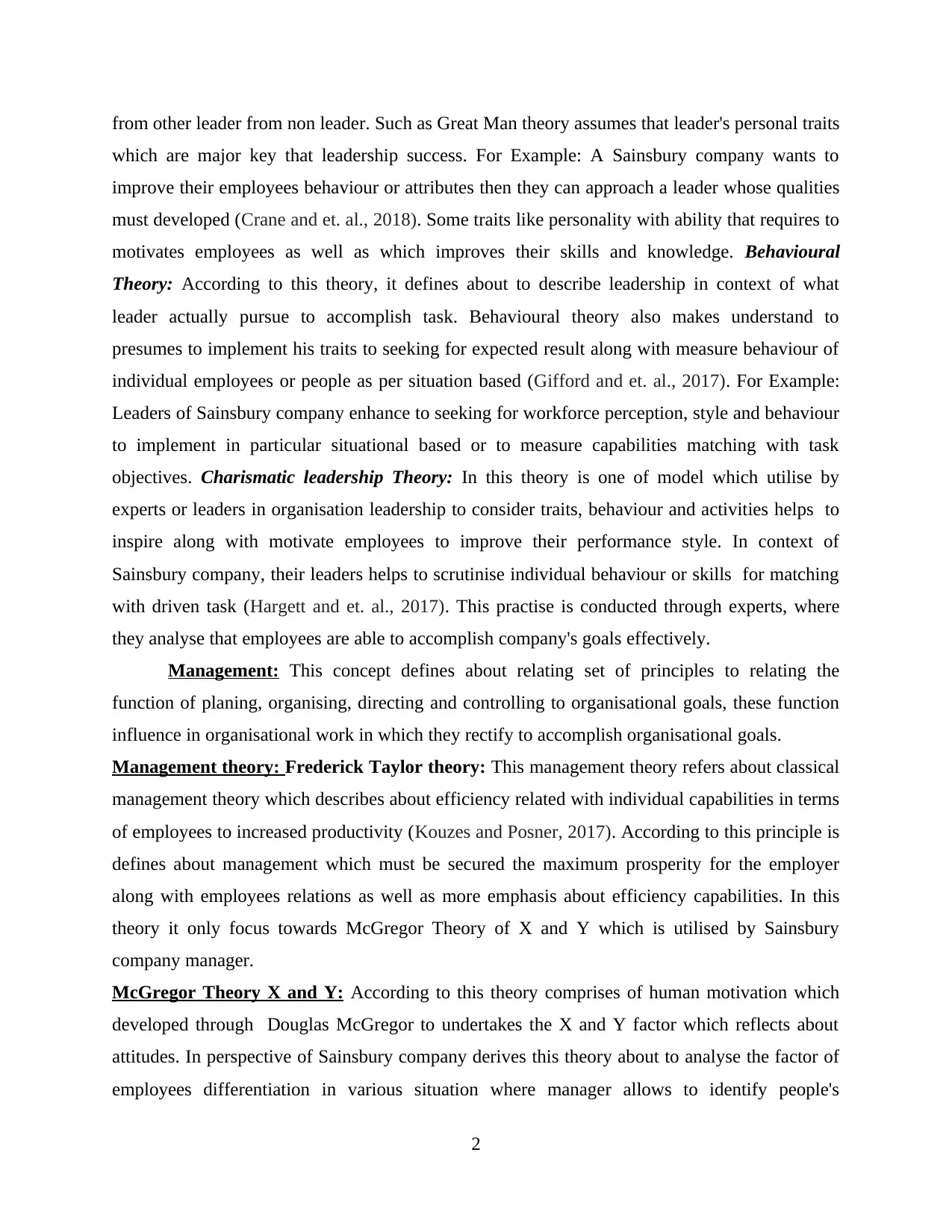
from other leader from non leader. Such as Great Man theory assumes that leader's personal traits
which are major key that leadership success. For Example: A Sainsbury company wants to
improve their employees behaviour or attributes then they can approach a leader whose qualities
must developed (Crane and et. al., 2018). Some traits like personality with ability that requires to
motivates employees as well as which improves their skills and knowledge. Behavioural
Theory: According to this theory, it defines about to describe leadership in context of what
leader actually pursue to accomplish task. Behavioural theory also makes understand to
presumes to implement his traits to seeking for expected result along with measure behaviour of
individual employees or people as per situation based (Gifford and et. al., 2017). For Example:
Leaders of Sainsbury company enhance to seeking for workforce perception, style and behaviour
to implement in particular situational based or to measure capabilities matching with task
objectives. Charismatic leadership Theory: In this theory is one of model which utilise by
experts or leaders in organisation leadership to consider traits, behaviour and activities helps to
inspire along with motivate employees to improve their performance style. In context of
Sainsbury company, their leaders helps to scrutinise individual behaviour or skills for matching
with driven task (Hargett and et. al., 2017). This practise is conducted through experts, where
they analyse that employees are able to accomplish company's goals effectively.
Management: This concept defines about relating set of principles to relating the
function of planing, organising, directing and controlling to organisational goals, these function
influence in organisational work in which they rectify to accomplish organisational goals.
Management theory: Frederick Taylor theory: This management theory refers about classical
management theory which describes about efficiency related with individual capabilities in terms
of employees to increased productivity (Kouzes and Posner, 2017). According to this principle is
defines about management which must be secured the maximum prosperity for the employer
along with employees relations as well as more emphasis about efficiency capabilities. In this
theory it only focus towards McGregor Theory of X and Y which is utilised by Sainsbury
company manager.
McGregor Theory X and Y: According to this theory comprises of human motivation which
developed through Douglas McGregor to undertakes the X and Y factor which reflects about
attitudes. In perspective of Sainsbury company derives this theory about to analyse the factor of
employees differentiation in various situation where manager allows to identify people's
2
which are major key that leadership success. For Example: A Sainsbury company wants to
improve their employees behaviour or attributes then they can approach a leader whose qualities
must developed (Crane and et. al., 2018). Some traits like personality with ability that requires to
motivates employees as well as which improves their skills and knowledge. Behavioural
Theory: According to this theory, it defines about to describe leadership in context of what
leader actually pursue to accomplish task. Behavioural theory also makes understand to
presumes to implement his traits to seeking for expected result along with measure behaviour of
individual employees or people as per situation based (Gifford and et. al., 2017). For Example:
Leaders of Sainsbury company enhance to seeking for workforce perception, style and behaviour
to implement in particular situational based or to measure capabilities matching with task
objectives. Charismatic leadership Theory: In this theory is one of model which utilise by
experts or leaders in organisation leadership to consider traits, behaviour and activities helps to
inspire along with motivate employees to improve their performance style. In context of
Sainsbury company, their leaders helps to scrutinise individual behaviour or skills for matching
with driven task (Hargett and et. al., 2017). This practise is conducted through experts, where
they analyse that employees are able to accomplish company's goals effectively.
Management: This concept defines about relating set of principles to relating the
function of planing, organising, directing and controlling to organisational goals, these function
influence in organisational work in which they rectify to accomplish organisational goals.
Management theory: Frederick Taylor theory: This management theory refers about classical
management theory which describes about efficiency related with individual capabilities in terms
of employees to increased productivity (Kouzes and Posner, 2017). According to this principle is
defines about management which must be secured the maximum prosperity for the employer
along with employees relations as well as more emphasis about efficiency capabilities. In this
theory it only focus towards McGregor Theory of X and Y which is utilised by Sainsbury
company manager.
McGregor Theory X and Y: According to this theory comprises of human motivation which
developed through Douglas McGregor to undertakes the X and Y factor which reflects about
attitudes. In perspective of Sainsbury company derives this theory about to analyse the factor of
employees differentiation in various situation where manager allows to identify people's
2
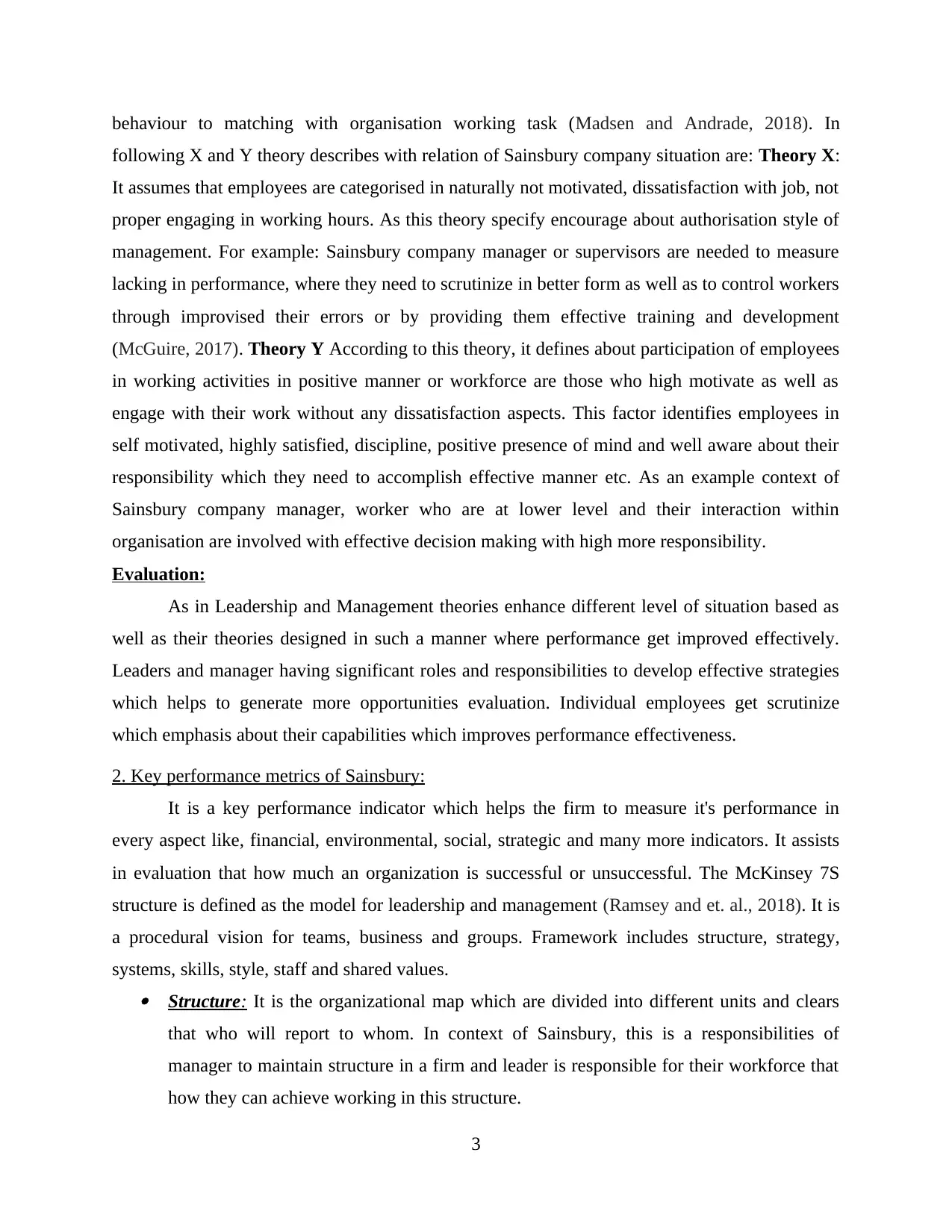
behaviour to matching with organisation working task (Madsen and Andrade, 2018). In
following X and Y theory describes with relation of Sainsbury company situation are: Theory X:
It assumes that employees are categorised in naturally not motivated, dissatisfaction with job, not
proper engaging in working hours. As this theory specify encourage about authorisation style of
management. For example: Sainsbury company manager or supervisors are needed to measure
lacking in performance, where they need to scrutinize in better form as well as to control workers
through improvised their errors or by providing them effective training and development
(McGuire, 2017). Theory Y According to this theory, it defines about participation of employees
in working activities in positive manner or workforce are those who high motivate as well as
engage with their work without any dissatisfaction aspects. This factor identifies employees in
self motivated, highly satisfied, discipline, positive presence of mind and well aware about their
responsibility which they need to accomplish effective manner etc. As an example context of
Sainsbury company manager, worker who are at lower level and their interaction within
organisation are involved with effective decision making with high more responsibility.
Evaluation:
As in Leadership and Management theories enhance different level of situation based as
well as their theories designed in such a manner where performance get improved effectively.
Leaders and manager having significant roles and responsibilities to develop effective strategies
which helps to generate more opportunities evaluation. Individual employees get scrutinize
which emphasis about their capabilities which improves performance effectiveness.
2. Key performance metrics of Sainsbury:
It is a key performance indicator which helps the firm to measure it's performance in
every aspect like, financial, environmental, social, strategic and many more indicators. It assists
in evaluation that how much an organization is successful or unsuccessful. The McKinsey 7S
structure is defined as the model for leadership and management (Ramsey and et. al., 2018). It is
a procedural vision for teams, business and groups. Framework includes structure, strategy,
systems, skills, style, staff and shared values. Structure: It is the organizational map which are divided into different units and clears
that who will report to whom. In context of Sainsbury, this is a responsibilities of
manager to maintain structure in a firm and leader is responsible for their workforce that
how they can achieve working in this structure.
3
following X and Y theory describes with relation of Sainsbury company situation are: Theory X:
It assumes that employees are categorised in naturally not motivated, dissatisfaction with job, not
proper engaging in working hours. As this theory specify encourage about authorisation style of
management. For example: Sainsbury company manager or supervisors are needed to measure
lacking in performance, where they need to scrutinize in better form as well as to control workers
through improvised their errors or by providing them effective training and development
(McGuire, 2017). Theory Y According to this theory, it defines about participation of employees
in working activities in positive manner or workforce are those who high motivate as well as
engage with their work without any dissatisfaction aspects. This factor identifies employees in
self motivated, highly satisfied, discipline, positive presence of mind and well aware about their
responsibility which they need to accomplish effective manner etc. As an example context of
Sainsbury company manager, worker who are at lower level and their interaction within
organisation are involved with effective decision making with high more responsibility.
Evaluation:
As in Leadership and Management theories enhance different level of situation based as
well as their theories designed in such a manner where performance get improved effectively.
Leaders and manager having significant roles and responsibilities to develop effective strategies
which helps to generate more opportunities evaluation. Individual employees get scrutinize
which emphasis about their capabilities which improves performance effectiveness.
2. Key performance metrics of Sainsbury:
It is a key performance indicator which helps the firm to measure it's performance in
every aspect like, financial, environmental, social, strategic and many more indicators. It assists
in evaluation that how much an organization is successful or unsuccessful. The McKinsey 7S
structure is defined as the model for leadership and management (Ramsey and et. al., 2018). It is
a procedural vision for teams, business and groups. Framework includes structure, strategy,
systems, skills, style, staff and shared values. Structure: It is the organizational map which are divided into different units and clears
that who will report to whom. In context of Sainsbury, this is a responsibilities of
manager to maintain structure in a firm and leader is responsible for their workforce that
how they can achieve working in this structure.
3
⊘ This is a preview!⊘
Do you want full access?
Subscribe today to unlock all pages.

Trusted by 1+ million students worldwide
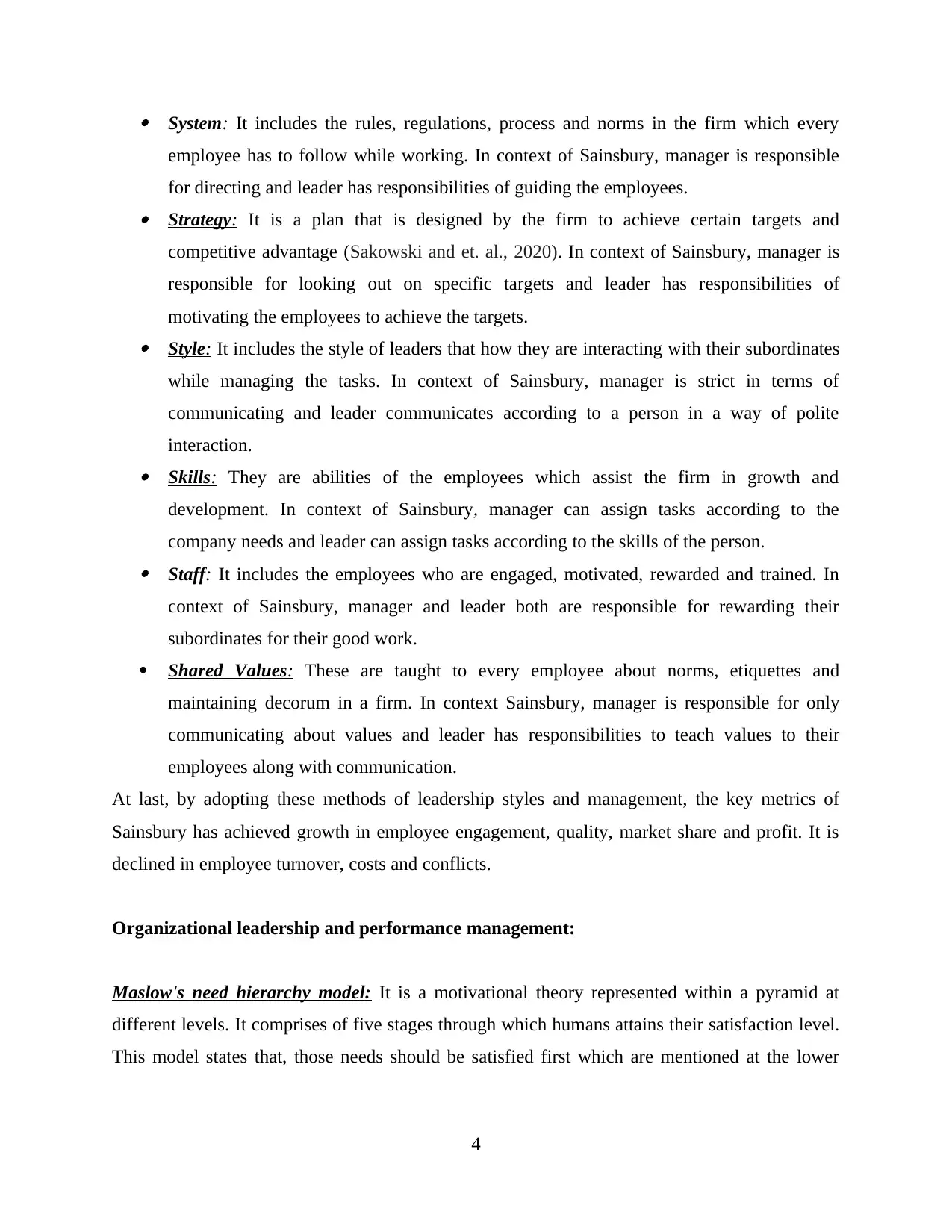
System: It includes the rules, regulations, process and norms in the firm which every
employee has to follow while working. In context of Sainsbury, manager is responsible
for directing and leader has responsibilities of guiding the employees. Strategy: It is a plan that is designed by the firm to achieve certain targets and
competitive advantage (Sakowski and et. al., 2020). In context of Sainsbury, manager is
responsible for looking out on specific targets and leader has responsibilities of
motivating the employees to achieve the targets. Style: It includes the style of leaders that how they are interacting with their subordinates
while managing the tasks. In context of Sainsbury, manager is strict in terms of
communicating and leader communicates according to a person in a way of polite
interaction. Skills: They are abilities of the employees which assist the firm in growth and
development. In context of Sainsbury, manager can assign tasks according to the
company needs and leader can assign tasks according to the skills of the person. Staff: It includes the employees who are engaged, motivated, rewarded and trained. In
context of Sainsbury, manager and leader both are responsible for rewarding their
subordinates for their good work.
Shared Values: These are taught to every employee about norms, etiquettes and
maintaining decorum in a firm. In context Sainsbury, manager is responsible for only
communicating about values and leader has responsibilities to teach values to their
employees along with communication.
At last, by adopting these methods of leadership styles and management, the key metrics of
Sainsbury has achieved growth in employee engagement, quality, market share and profit. It is
declined in employee turnover, costs and conflicts.
Organizational leadership and performance management:
Maslow's need hierarchy model: It is a motivational theory represented within a pyramid at
different levels. It comprises of five stages through which humans attains their satisfaction level.
This model states that, those needs should be satisfied first which are mentioned at the lower
4
employee has to follow while working. In context of Sainsbury, manager is responsible
for directing and leader has responsibilities of guiding the employees. Strategy: It is a plan that is designed by the firm to achieve certain targets and
competitive advantage (Sakowski and et. al., 2020). In context of Sainsbury, manager is
responsible for looking out on specific targets and leader has responsibilities of
motivating the employees to achieve the targets. Style: It includes the style of leaders that how they are interacting with their subordinates
while managing the tasks. In context of Sainsbury, manager is strict in terms of
communicating and leader communicates according to a person in a way of polite
interaction. Skills: They are abilities of the employees which assist the firm in growth and
development. In context of Sainsbury, manager can assign tasks according to the
company needs and leader can assign tasks according to the skills of the person. Staff: It includes the employees who are engaged, motivated, rewarded and trained. In
context of Sainsbury, manager and leader both are responsible for rewarding their
subordinates for their good work.
Shared Values: These are taught to every employee about norms, etiquettes and
maintaining decorum in a firm. In context Sainsbury, manager is responsible for only
communicating about values and leader has responsibilities to teach values to their
employees along with communication.
At last, by adopting these methods of leadership styles and management, the key metrics of
Sainsbury has achieved growth in employee engagement, quality, market share and profit. It is
declined in employee turnover, costs and conflicts.
Organizational leadership and performance management:
Maslow's need hierarchy model: It is a motivational theory represented within a pyramid at
different levels. It comprises of five stages through which humans attains their satisfaction level.
This model states that, those needs should be satisfied first which are mentioned at the lower
4
Paraphrase This Document
Need a fresh take? Get an instant paraphrase of this document with our AI Paraphraser
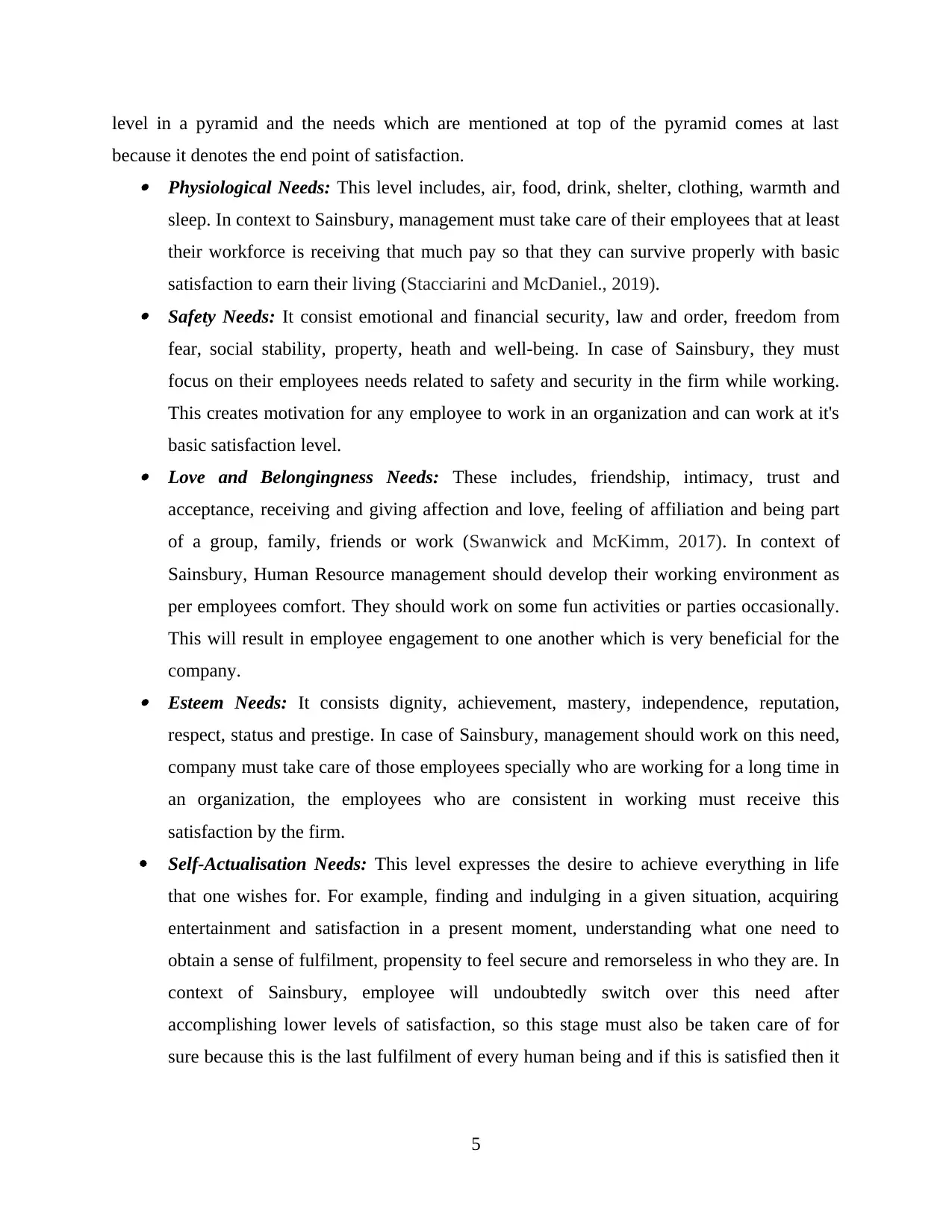
level in a pyramid and the needs which are mentioned at top of the pyramid comes at last
because it denotes the end point of satisfaction. Physiological Needs: This level includes, air, food, drink, shelter, clothing, warmth and
sleep. In context to Sainsbury, management must take care of their employees that at least
their workforce is receiving that much pay so that they can survive properly with basic
satisfaction to earn their living (Stacciarini and McDaniel., 2019). Safety Needs: It consist emotional and financial security, law and order, freedom from
fear, social stability, property, heath and well-being. In case of Sainsbury, they must
focus on their employees needs related to safety and security in the firm while working.
This creates motivation for any employee to work in an organization and can work at it's
basic satisfaction level. Love and Belongingness Needs: These includes, friendship, intimacy, trust and
acceptance, receiving and giving affection and love, feeling of affiliation and being part
of a group, family, friends or work (Swanwick and McKimm, 2017). In context of
Sainsbury, Human Resource management should develop their working environment as
per employees comfort. They should work on some fun activities or parties occasionally.
This will result in employee engagement to one another which is very beneficial for the
company. Esteem Needs: It consists dignity, achievement, mastery, independence, reputation,
respect, status and prestige. In case of Sainsbury, management should work on this need,
company must take care of those employees specially who are working for a long time in
an organization, the employees who are consistent in working must receive this
satisfaction by the firm.
Self-Actualisation Needs: This level expresses the desire to achieve everything in life
that one wishes for. For example, finding and indulging in a given situation, acquiring
entertainment and satisfaction in a present moment, understanding what one need to
obtain a sense of fulfilment, propensity to feel secure and remorseless in who they are. In
context of Sainsbury, employee will undoubtedly switch over this need after
accomplishing lower levels of satisfaction, so this stage must also be taken care of for
sure because this is the last fulfilment of every human being and if this is satisfied then it
5
because it denotes the end point of satisfaction. Physiological Needs: This level includes, air, food, drink, shelter, clothing, warmth and
sleep. In context to Sainsbury, management must take care of their employees that at least
their workforce is receiving that much pay so that they can survive properly with basic
satisfaction to earn their living (Stacciarini and McDaniel., 2019). Safety Needs: It consist emotional and financial security, law and order, freedom from
fear, social stability, property, heath and well-being. In case of Sainsbury, they must
focus on their employees needs related to safety and security in the firm while working.
This creates motivation for any employee to work in an organization and can work at it's
basic satisfaction level. Love and Belongingness Needs: These includes, friendship, intimacy, trust and
acceptance, receiving and giving affection and love, feeling of affiliation and being part
of a group, family, friends or work (Swanwick and McKimm, 2017). In context of
Sainsbury, Human Resource management should develop their working environment as
per employees comfort. They should work on some fun activities or parties occasionally.
This will result in employee engagement to one another which is very beneficial for the
company. Esteem Needs: It consists dignity, achievement, mastery, independence, reputation,
respect, status and prestige. In case of Sainsbury, management should work on this need,
company must take care of those employees specially who are working for a long time in
an organization, the employees who are consistent in working must receive this
satisfaction by the firm.
Self-Actualisation Needs: This level expresses the desire to achieve everything in life
that one wishes for. For example, finding and indulging in a given situation, acquiring
entertainment and satisfaction in a present moment, understanding what one need to
obtain a sense of fulfilment, propensity to feel secure and remorseless in who they are. In
context of Sainsbury, employee will undoubtedly switch over this need after
accomplishing lower levels of satisfaction, so this stage must also be taken care of for
sure because this is the last fulfilment of every human being and if this is satisfied then it
5
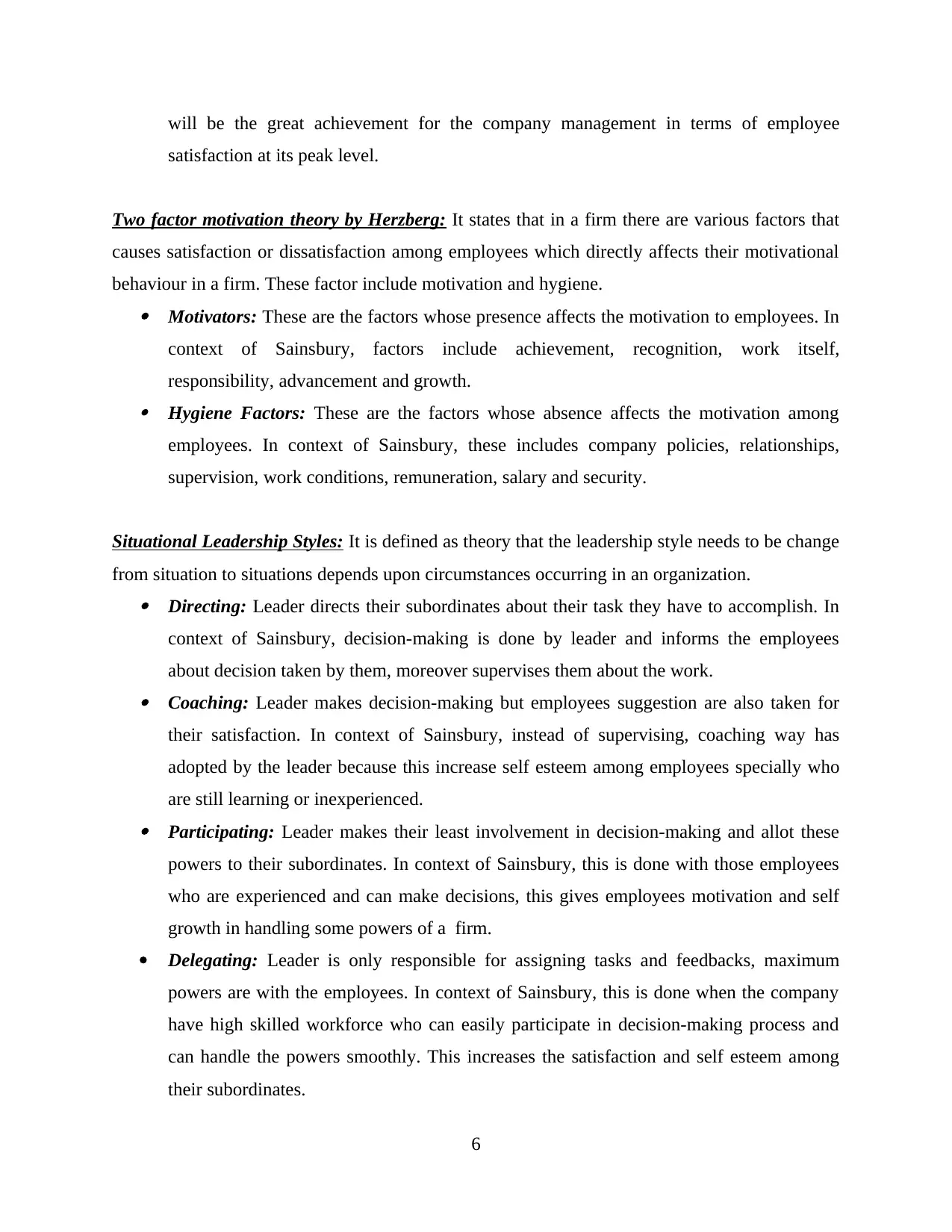
will be the great achievement for the company management in terms of employee
satisfaction at its peak level.
Two factor motivation theory by Herzberg: It states that in a firm there are various factors that
causes satisfaction or dissatisfaction among employees which directly affects their motivational
behaviour in a firm. These factor include motivation and hygiene. Motivators: These are the factors whose presence affects the motivation to employees. In
context of Sainsbury, factors include achievement, recognition, work itself,
responsibility, advancement and growth. Hygiene Factors: These are the factors whose absence affects the motivation among
employees. In context of Sainsbury, these includes company policies, relationships,
supervision, work conditions, remuneration, salary and security.
Situational Leadership Styles: It is defined as theory that the leadership style needs to be change
from situation to situations depends upon circumstances occurring in an organization. Directing: Leader directs their subordinates about their task they have to accomplish. In
context of Sainsbury, decision-making is done by leader and informs the employees
about decision taken by them, moreover supervises them about the work. Coaching: Leader makes decision-making but employees suggestion are also taken for
their satisfaction. In context of Sainsbury, instead of supervising, coaching way has
adopted by the leader because this increase self esteem among employees specially who
are still learning or inexperienced. Participating: Leader makes their least involvement in decision-making and allot these
powers to their subordinates. In context of Sainsbury, this is done with those employees
who are experienced and can make decisions, this gives employees motivation and self
growth in handling some powers of a firm.
Delegating: Leader is only responsible for assigning tasks and feedbacks, maximum
powers are with the employees. In context of Sainsbury, this is done when the company
have high skilled workforce who can easily participate in decision-making process and
can handle the powers smoothly. This increases the satisfaction and self esteem among
their subordinates.
6
satisfaction at its peak level.
Two factor motivation theory by Herzberg: It states that in a firm there are various factors that
causes satisfaction or dissatisfaction among employees which directly affects their motivational
behaviour in a firm. These factor include motivation and hygiene. Motivators: These are the factors whose presence affects the motivation to employees. In
context of Sainsbury, factors include achievement, recognition, work itself,
responsibility, advancement and growth. Hygiene Factors: These are the factors whose absence affects the motivation among
employees. In context of Sainsbury, these includes company policies, relationships,
supervision, work conditions, remuneration, salary and security.
Situational Leadership Styles: It is defined as theory that the leadership style needs to be change
from situation to situations depends upon circumstances occurring in an organization. Directing: Leader directs their subordinates about their task they have to accomplish. In
context of Sainsbury, decision-making is done by leader and informs the employees
about decision taken by them, moreover supervises them about the work. Coaching: Leader makes decision-making but employees suggestion are also taken for
their satisfaction. In context of Sainsbury, instead of supervising, coaching way has
adopted by the leader because this increase self esteem among employees specially who
are still learning or inexperienced. Participating: Leader makes their least involvement in decision-making and allot these
powers to their subordinates. In context of Sainsbury, this is done with those employees
who are experienced and can make decisions, this gives employees motivation and self
growth in handling some powers of a firm.
Delegating: Leader is only responsible for assigning tasks and feedbacks, maximum
powers are with the employees. In context of Sainsbury, this is done when the company
have high skilled workforce who can easily participate in decision-making process and
can handle the powers smoothly. This increases the satisfaction and self esteem among
their subordinates.
6
⊘ This is a preview!⊘
Do you want full access?
Subscribe today to unlock all pages.

Trusted by 1+ million students worldwide
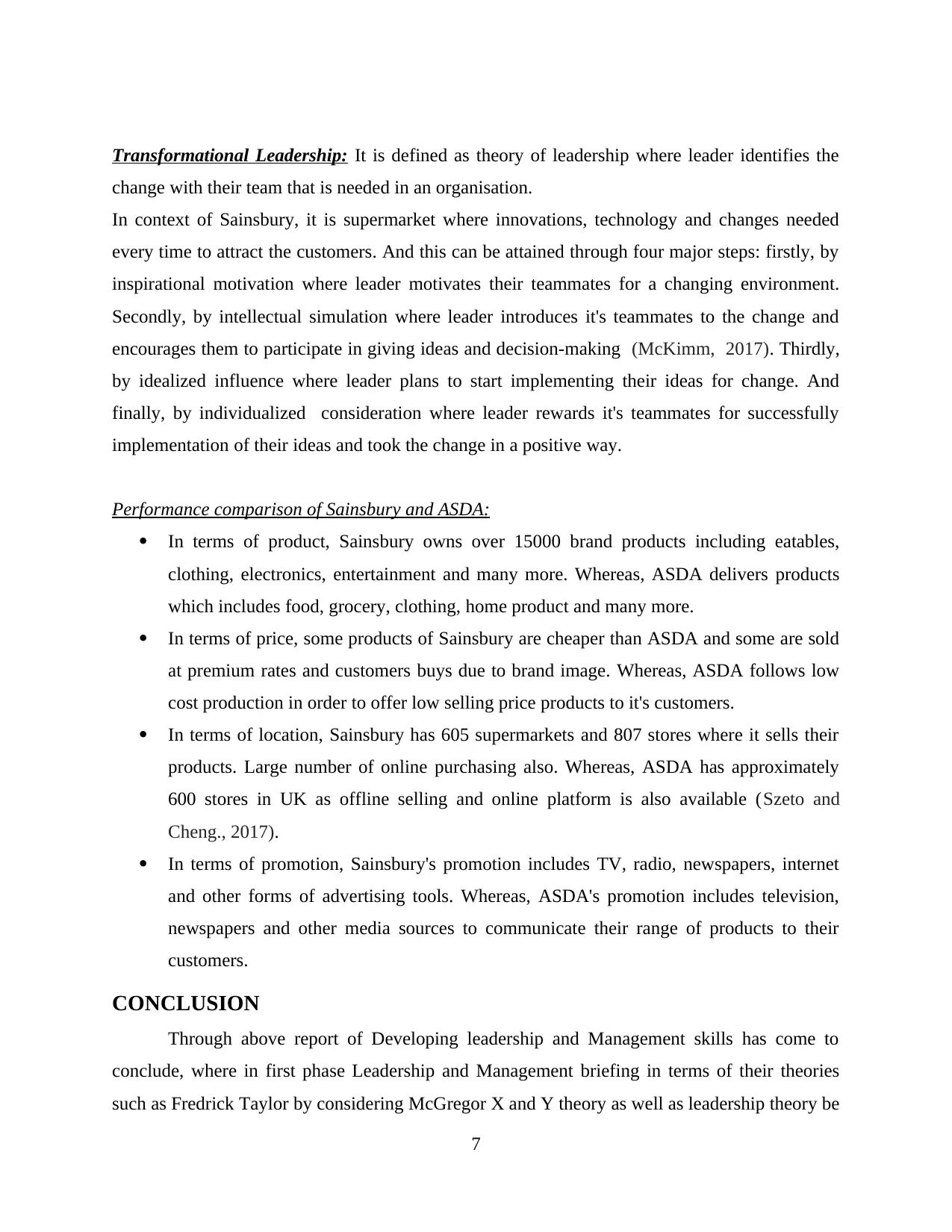
Transformational Leadership: It is defined as theory of leadership where leader identifies the
change with their team that is needed in an organisation.
In context of Sainsbury, it is supermarket where innovations, technology and changes needed
every time to attract the customers. And this can be attained through four major steps: firstly, by
inspirational motivation where leader motivates their teammates for a changing environment.
Secondly, by intellectual simulation where leader introduces it's teammates to the change and
encourages them to participate in giving ideas and decision-making (McKimm, 2017). Thirdly,
by idealized influence where leader plans to start implementing their ideas for change. And
finally, by individualized consideration where leader rewards it's teammates for successfully
implementation of their ideas and took the change in a positive way.
Performance comparison of Sainsbury and ASDA:
In terms of product, Sainsbury owns over 15000 brand products including eatables,
clothing, electronics, entertainment and many more. Whereas, ASDA delivers products
which includes food, grocery, clothing, home product and many more.
In terms of price, some products of Sainsbury are cheaper than ASDA and some are sold
at premium rates and customers buys due to brand image. Whereas, ASDA follows low
cost production in order to offer low selling price products to it's customers.
In terms of location, Sainsbury has 605 supermarkets and 807 stores where it sells their
products. Large number of online purchasing also. Whereas, ASDA has approximately
600 stores in UK as offline selling and online platform is also available (Szeto and
Cheng., 2017).
In terms of promotion, Sainsbury's promotion includes TV, radio, newspapers, internet
and other forms of advertising tools. Whereas, ASDA's promotion includes television,
newspapers and other media sources to communicate their range of products to their
customers.
CONCLUSION
Through above report of Developing leadership and Management skills has come to
conclude, where in first phase Leadership and Management briefing in terms of their theories
such as Fredrick Taylor by considering McGregor X and Y theory as well as leadership theory be
7
change with their team that is needed in an organisation.
In context of Sainsbury, it is supermarket where innovations, technology and changes needed
every time to attract the customers. And this can be attained through four major steps: firstly, by
inspirational motivation where leader motivates their teammates for a changing environment.
Secondly, by intellectual simulation where leader introduces it's teammates to the change and
encourages them to participate in giving ideas and decision-making (McKimm, 2017). Thirdly,
by idealized influence where leader plans to start implementing their ideas for change. And
finally, by individualized consideration where leader rewards it's teammates for successfully
implementation of their ideas and took the change in a positive way.
Performance comparison of Sainsbury and ASDA:
In terms of product, Sainsbury owns over 15000 brand products including eatables,
clothing, electronics, entertainment and many more. Whereas, ASDA delivers products
which includes food, grocery, clothing, home product and many more.
In terms of price, some products of Sainsbury are cheaper than ASDA and some are sold
at premium rates and customers buys due to brand image. Whereas, ASDA follows low
cost production in order to offer low selling price products to it's customers.
In terms of location, Sainsbury has 605 supermarkets and 807 stores where it sells their
products. Large number of online purchasing also. Whereas, ASDA has approximately
600 stores in UK as offline selling and online platform is also available (Szeto and
Cheng., 2017).
In terms of promotion, Sainsbury's promotion includes TV, radio, newspapers, internet
and other forms of advertising tools. Whereas, ASDA's promotion includes television,
newspapers and other media sources to communicate their range of products to their
customers.
CONCLUSION
Through above report of Developing leadership and Management skills has come to
conclude, where in first phase Leadership and Management briefing in terms of their theories
such as Fredrick Taylor by considering McGregor X and Y theory as well as leadership theory be
7
Paraphrase This Document
Need a fresh take? Get an instant paraphrase of this document with our AI Paraphraser
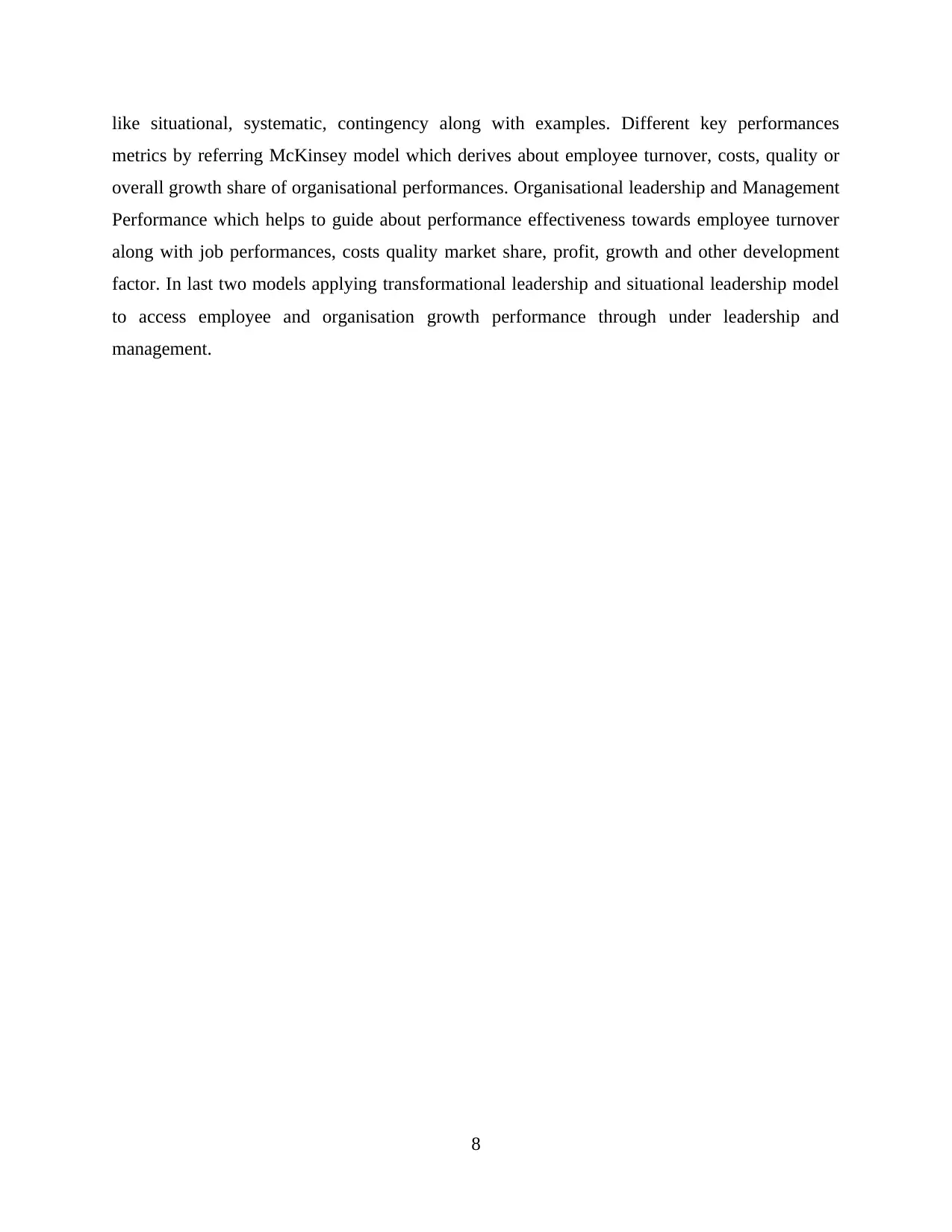
like situational, systematic, contingency along with examples. Different key performances
metrics by referring McKinsey model which derives about employee turnover, costs, quality or
overall growth share of organisational performances. Organisational leadership and Management
Performance which helps to guide about performance effectiveness towards employee turnover
along with job performances, costs quality market share, profit, growth and other development
factor. In last two models applying transformational leadership and situational leadership model
to access employee and organisation growth performance through under leadership and
management.
8
metrics by referring McKinsey model which derives about employee turnover, costs, quality or
overall growth share of organisational performances. Organisational leadership and Management
Performance which helps to guide about performance effectiveness towards employee turnover
along with job performances, costs quality market share, profit, growth and other development
factor. In last two models applying transformational leadership and situational leadership model
to access employee and organisation growth performance through under leadership and
management.
8
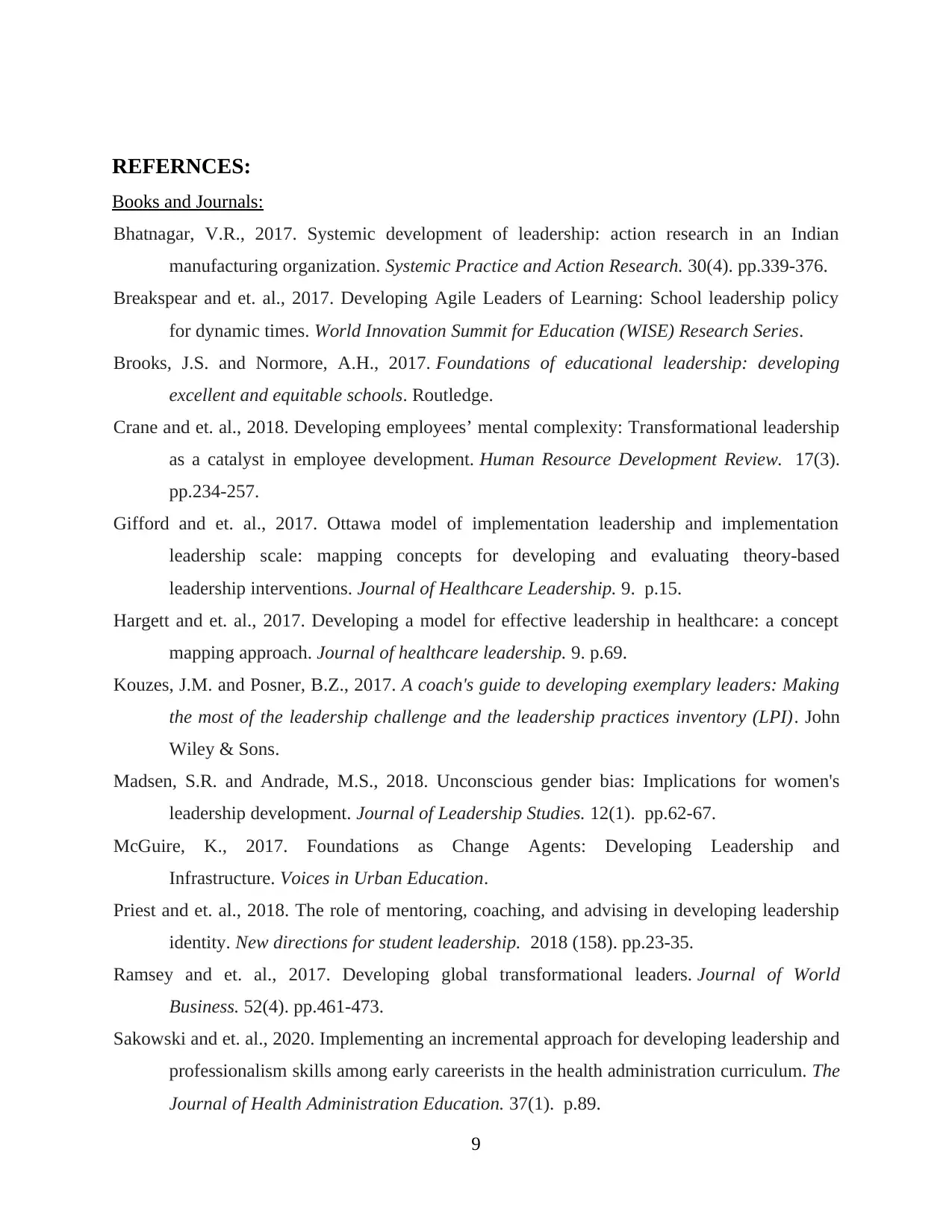
REFERNCES:
Books and Journals:
Bhatnagar, V.R., 2017. Systemic development of leadership: action research in an Indian
manufacturing organization. Systemic Practice and Action Research. 30(4). pp.339-376.
Breakspear and et. al., 2017. Developing Agile Leaders of Learning: School leadership policy
for dynamic times. World Innovation Summit for Education (WISE) Research Series.
Brooks, J.S. and Normore, A.H., 2017. Foundations of educational leadership: developing
excellent and equitable schools. Routledge.
Crane and et. al., 2018. Developing employees’ mental complexity: Transformational leadership
as a catalyst in employee development. Human Resource Development Review. 17(3).
pp.234-257.
Gifford and et. al., 2017. Ottawa model of implementation leadership and implementation
leadership scale: mapping concepts for developing and evaluating theory-based
leadership interventions. Journal of Healthcare Leadership. 9. p.15.
Hargett and et. al., 2017. Developing a model for effective leadership in healthcare: a concept
mapping approach. Journal of healthcare leadership. 9. p.69.
Kouzes, J.M. and Posner, B.Z., 2017. A coach's guide to developing exemplary leaders: Making
the most of the leadership challenge and the leadership practices inventory (LPI). John
Wiley & Sons.
Madsen, S.R. and Andrade, M.S., 2018. Unconscious gender bias: Implications for women's
leadership development. Journal of Leadership Studies. 12(1). pp.62-67.
McGuire, K., 2017. Foundations as Change Agents: Developing Leadership and
Infrastructure. Voices in Urban Education.
Priest and et. al., 2018. The role of mentoring, coaching, and advising in developing leadership
identity. New directions for student leadership. 2018 (158). pp.23-35.
Ramsey and et. al., 2017. Developing global transformational leaders. Journal of World
Business. 52(4). pp.461-473.
Sakowski and et. al., 2020. Implementing an incremental approach for developing leadership and
professionalism skills among early careerists in the health administration curriculum. The
Journal of Health Administration Education. 37(1). p.89.
9
Books and Journals:
Bhatnagar, V.R., 2017. Systemic development of leadership: action research in an Indian
manufacturing organization. Systemic Practice and Action Research. 30(4). pp.339-376.
Breakspear and et. al., 2017. Developing Agile Leaders of Learning: School leadership policy
for dynamic times. World Innovation Summit for Education (WISE) Research Series.
Brooks, J.S. and Normore, A.H., 2017. Foundations of educational leadership: developing
excellent and equitable schools. Routledge.
Crane and et. al., 2018. Developing employees’ mental complexity: Transformational leadership
as a catalyst in employee development. Human Resource Development Review. 17(3).
pp.234-257.
Gifford and et. al., 2017. Ottawa model of implementation leadership and implementation
leadership scale: mapping concepts for developing and evaluating theory-based
leadership interventions. Journal of Healthcare Leadership. 9. p.15.
Hargett and et. al., 2017. Developing a model for effective leadership in healthcare: a concept
mapping approach. Journal of healthcare leadership. 9. p.69.
Kouzes, J.M. and Posner, B.Z., 2017. A coach's guide to developing exemplary leaders: Making
the most of the leadership challenge and the leadership practices inventory (LPI). John
Wiley & Sons.
Madsen, S.R. and Andrade, M.S., 2018. Unconscious gender bias: Implications for women's
leadership development. Journal of Leadership Studies. 12(1). pp.62-67.
McGuire, K., 2017. Foundations as Change Agents: Developing Leadership and
Infrastructure. Voices in Urban Education.
Priest and et. al., 2018. The role of mentoring, coaching, and advising in developing leadership
identity. New directions for student leadership. 2018 (158). pp.23-35.
Ramsey and et. al., 2017. Developing global transformational leaders. Journal of World
Business. 52(4). pp.461-473.
Sakowski and et. al., 2020. Implementing an incremental approach for developing leadership and
professionalism skills among early careerists in the health administration curriculum. The
Journal of Health Administration Education. 37(1). p.89.
9
⊘ This is a preview!⊘
Do you want full access?
Subscribe today to unlock all pages.

Trusted by 1+ million students worldwide
1 out of 13
Related Documents
Your All-in-One AI-Powered Toolkit for Academic Success.
+13062052269
info@desklib.com
Available 24*7 on WhatsApp / Email
![[object Object]](/_next/static/media/star-bottom.7253800d.svg)
Unlock your academic potential
Copyright © 2020–2026 A2Z Services. All Rights Reserved. Developed and managed by ZUCOL.





